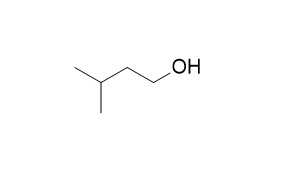3-Methyl-1-butanol
3‐Methyl‐1‐butanol is a volatile anti‐cyanobacterial and phytotoxic product of some Bacillus spp.
Inquire / Order:
manager@chemfaces.com
Technical Inquiries:
service@chemfaces.com
Tel:
+86-27-84237783
Fax:
+86-27-84254680
Address:
1 Building, No. 83, CheCheng Rd., Wuhan Economic and Technological Development Zone, Wuhan, Hubei 430056, PRC
Providing storage is as stated on the product vial and the vial is kept tightly sealed, the product can be stored for up to
24 months(2-8C).
Wherever possible, you should prepare and use solutions on the same day. However, if you need to make up stock solutions in advance, we recommend that you store the solution as aliquots in tightly sealed vials at -20C. Generally, these will be useable for up to two weeks. Before use, and prior to opening the vial we recommend that you allow your product to equilibrate to room temperature for at least 1 hour.
Need more advice on solubility, usage and handling? Please email to: service@chemfaces.com
The packaging of the product may have turned upside down during transportation, resulting in the natural compounds adhering to the neck or cap of the vial. take the vial out of its packaging and gently shake to let the compounds fall to the bottom of the vial. for liquid products, centrifuge at 200-500 RPM to gather the liquid at the bottom of the vial. try to avoid loss or contamination during handling.
Mutlu Yanic S, Ates EG. JOTCSA.2023, 10(4);893-902.
Br J Pharmacol.2018, 175(6):902-923
J Appl Biol Chem.2024, 67:33,238-244
Nat Commun.2019, 10(1):2745
Biomed Chromatogr.2020, e5021.
Front Pharmacol.2021, 12:762829.
Anesth Pain Med (Seoul).2020, 15(4):478-485.
Molecules.2016, 21(6)
Journal of Apicultural Research2021, 60(1).
Food Bioscience2023, 59:103903
Related and Featured Products
Journal of Chemical Ecology, 1998, 24(11):1867-1880.
Attraction of 3-Methyl-1-Butanol and Ammonia Identified from Enterobacter agglomerans to Anastrepha suspensa。[Reference:
WebLink]
METHODS AND RESULTS:
Tests demonstrated that volatile chemicals emitted from Enterobacter agglomerans, a bacterium that has been isolated from adults as well as fruit infested with larvae of the Caribbean fruit fly, Anastrepha suspensa (Loew) and other pest fruit flies, are attractive to female A. suspensa in laboratory bioassays. 3-Methyl-1-butanol and ammonia were identified as the two primary volatile chemicals released from active cultures of E. agglomerans. No 3-Methyl-1-butanol and little ammonia (16.0 μg/hr) are released from sterile tryptic soy agar plates. E. agglomerans-inoculated tryptic soy agar plates, however, released an average of 1.5 ± 0.53 μg/hr 3-Methyl-1-butanol and 332.9 ± 239.16 μg/hr ammonia after 24 hr of growth. 3-Methyl-1-butanol lures were formulated in a membrane-based system to provide a constant release rate of synthetic chemical. Release rates ranged from 0.046 ± 0.007 to 12.16 ± 2.76 μg/hr. In laboratory tests, equal numbers of females were captured in response to ammonium carbonate lures that released ammonia at the rate of 100 μg/hr and to 3-Methyl-1-butanol lures that released 12.16 ± 2.756 μg/hr of synthetic material. The combination of the two lures was more attractive than ammonia alone.
CONCLUSIONS:
Availability of lures formulated for a range of 3-Methyl-1-butanol release rates will facilitate field tests of this putative microbial attractant and may lead to a better understanding of the role of bacteria in the ecology of pest fruit flies.
Letters in Applied Microbiology, 1991, 13(3):130-132.
Isoamyl alcohol (3‐methyl‐1‐butanol), a volatile anti‐cyanobacterial and phytotoxic product of some Bacillus spp.[Reference:
WebLink]
METHODS AND RESULTS:
More than fifty volatile organic compounds were detected in the headspace gas of Bacillus cultures in a peptone medium. Of these, isoamyl alcohol (3-Methyl-1-butanol) is implicated as a cyanobacteriolytic agent.



